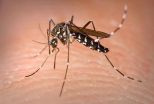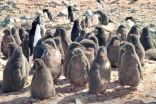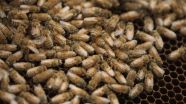(Press-News.org) Rice University researchers have delivered a scientific one-two punch with a pair of papers that detail how synthetic collagen fibers self-assemble via their sticky ends.
Collagen is the most common protein in mammals, a major component of bone and the fibrous tissues that support cells and hold organs together. Discovering its secrets may lead to better synthetic collagen for tissue engineering and cosmetic and reconstructive medicine.
The Rice lab of Jeffrey Hartgerink has been studying synthetic collagen for a decade, teasing out the details of how it starts as three distinct peptides that twist into characteristic triple helices. His group has already developed collagens for use as clotting agents or as scaffolding in regenerative medicine.
The two papers in the Journal of the American Chemical Society, the first published in May and the second this month, show precisely how mimetic peptides developed at Rice may be aligned to form helices with sticky ends that allow them to aggregate into fibers or gels.
"We proposed in a Nature Chemistry paper (in 2011) that peptides self-assemble in an offset fashion that creates sticky ends," Hartgerink said. "And those sticky ends can then propagate. But even in the review of that paper, the mechanism took a fair amount of flak because there had been no reports in the literature that a collagen system could, in fact, create this offset."
It has taken several years and these two papers to prove the critics wrong, he said.
Collagen forms from helical arrangements of three protein chains, also called peptides. The chains, like all proteins, consist of amino acid like glycine and proline (two primary components of collagen) arranged in a certain order. Scientists like Hartgerink design custom nanoscale chains by carefully arranging the amino acids and their positive and negative charges.
In the right order, the charged amino acids crosslink into what Hartgerink calls axial salt bridges, non-covalent bonds that hold the helices together with the help of stabilizing hydrogen bonds. "Most of the work we've done on collagen has been to define those axial charged pairs and then utilize them to do different things," he said.
The ends of these helices can be blunt or sticky, Hartgerink said, depending on how the chains are staggered, or offset. An offset of one amino acid is blunt and not sticky at all. The greater the offset, the stickier it becomes.
The first of the new papers by Hartgerink, graduate students Abihishek Jalan and Katherine Jochim demonstrated the self-assembly of standalone, sticky-ended triple helices with offsets of four amino acids. They allowed the researchers to obtain details of the structure through nuclear magnetic resonance (NMR).
"We chose to use a really short offset because as soon as we make it a little bit bigger, it becomes stickier and fibers start forming," Hartgerink said. "As soon as you have a fiber, NMR doesn't work any more. But NMR is the go-to analytical tool, and in this case we were able to show at a molecular level that the offset takes place."
For the second paper with graduate student Biplab Sarkar and former graduate student Lesley O'Leary, "We did the reverse of that and synthesized a series of peptides with large sticky ends that drive fiber assembly," Hartgerink said.
The researchers made two classes of synthetic collagen peptides with the same chemical components but different arrangements and showed those with extensive sticky ends quickly self-assembled into fibers. Those with misaligned sequences either formed amorphous aggregates or remained separated in solution.
"We chose to satisfy the critics by breaking our work into two studies. One was to demonstrate at the molecular level that these charged pairs are powerful and can drive this kind of offset, which hadn't been demonstrated before, and that the resulting helices are potentially sticky," he said. "Then, in the second study, we made them actually sticky and showed that when you use charged pairs properly, you get fibers. And when you don't, you don't get fibers."
Understanding the fine details of collagen assembly presents the possibility of synthetic collagens for specific functions, Hartgerink said. "A number of biomaterials use natural collagen, and there are advantages to replacing them with synthetic collagens," he said. "One of the main advantages is that we move away from health and regulatory problems associated with using animal sources."
He said synthetic collagen may also help answer important questions about its natural counterpart. "Collagen is an incredibly important central player in tissue behavior, but even some of the very basic ideas about collagen structure have eluded scientists for decades," he said. "One of the things we're pursuing now is generating libraries of collagen mimetic peptides to test them against known collagen-binding proteins and proteases, proteins that cut up collagen.
"I think the difficulty in understanding the mechanism is illustrated by the fact that it took two whole papers just to outline it," Hartgerink said. "But these mechanistic studies will allow us to push the science forward and do more practical things."
INFORMATION:
Read the abstract for "Rational Design of a Non-canonical 'Sticky-Ended' Collagen Triple Helix": http://pubs.acs.org/doi/abs/10.1021/ja5001246
Read the abstract for "Self-Assembly of Fiber-Forming Collagen Mimetic Peptides Controlled by Triple-Helical Nucleation": http://pubs.acs.org/doi/abs/10.1021/ja504377s
Follow Rice News and Media Relations via Twitter @RiceUNews
Related Materials:
Hartgerink Research Group: http://www.ruf.rice.edu/~jdh/publist.html
Rice Department of Bioengineering: http://bioe.rice.edu
2011 Nature Chemistry paper: http://www.nature.com/nchem/journal/v3/n10/full/nchem.1123.html
Images for download:
http://news.rice.edu/wp-content/uploads/2014/10/1027_COLLAGEN-1-WEB.jpg
A Rice University lab has discovered that synthetic peptides are more likely to self-assemble into collagen fibers and gels if the ends are left "sticky," with extended strands that allow more triple helices to attach. The lab experimented with both "sticky" and "blunt" helices to show how collagen, the most abundant protein in mammals, might self-assemble into fibrous tissues and bone. (Credit: Jeffrey Hartgerink/Rice University)
http://news.rice.edu/wp-content/uploads/2014/10/1027_COLLAGEN-2-WEB.jpg
Rice University graduate student Katherine Jochim, left, and chemist Jeffrey Hartgerink demonstrated the self-assembly of standalone, sticky-ended triple helices that form collagen, the most common protein in mammals. The Hartgerink lab's discoveries could lead to better synthetic materials for medical applications. (Credit: Jeff Fitlow/Rice University)
'Sticky' ends start synthetic collagen growth
Rice University chemists advance understanding, control of collagen formation
2014-10-27
ELSE PRESS RELEASES FROM THIS DATE:
Hot on the trail of the Asian tiger mosquito
2014-10-27
The Asian tiger mosquito (Aedes albopictus), which is native to Southeast Asia, was spotted in Houston in 1985. By 1986 it had reached St. Louis and Jacksonville, Fla. Today it can be found in all of the southern states and as far north as Maine.
An aggressive daytime biter, Ae. albopictus has an affinity for humans and is also a vector for human disease, said Kim Medley, PhD, interim director of the Tyson Research Center at Washington University in St. Louis.
The mosquito arrived in the U.S. in a shipment of used tires from Japan. Ae. albopictus lays eggs that can ...
University of Delaware study connects penguin chick weights to local weather conditions
2014-10-27
Adélie penguins are an indigenous species of the West Antarctic Peninsula (WAP), one of the most rapidly warming areas on Earth. Since 1950, the average annual temperature in the Antarctic Peninsula has increased 2 degrees Celsius on average, and 6 degrees Celsius during winter.
As the WAP climate warms, it is changing from a dry, polar system to a warmer, sub-polar system with more rain.
University of Delaware oceanographers recently reported a connection between local weather conditions and the weight of Adélie penguin chicks in an article in Marine Ecology ...
Cost of informal caregiving for US elderly is $522 billion annually, study finds
2014-10-27
The price tag for informal caregiving of elderly people by friends and relatives in the United States comes to $522 billion a year, according to a new RAND Corporation study.
Replacing that care with unskilled paid care at minimum wage would cost $221 billion, while replacing it with skilled nursing care would cost $642 billion annually.
The study, published online by the journal Health Services Research, improves on earlier estimates about the value of informal caregiving by making use of the 2011 and 2012 American Time Use Survey, a new and unique database, to provide ...
PET scans reveal how psychodynamic therapy for depression may change brain function
2014-10-27
A study from Massachusetts General Hospital (MGH) investigators has identified for the first time changes in the metabolic activity of a key brain region in patients successfully treated for depression with psychodynamic psychotherapy, suggesting a mechanism of action behind one of the most historically important and widely practiced forms of therapy. They also found evidence that pretreatment metabolism in a different brain structure might predict which patients are likely to respond to that form of therapy. Their report will appear in the journal Psychotherapy and Psychosomatics ...
Blood vessel growth in the brain relies on a protein found in tumor blood vessels
2014-10-27
Do blood vessels that feed tumors differ from other blood vessels? Fourteen years ago, experiments designed to answer that question led to the discovery of several genes that are more active in tumor-associated blood vessels than in normal blood vessels. New research now reveals the normal function of one of those genes and suggests it could be a good target for anticancer drug therapy.
A summary of the research appears in the journal Developmental Cell on Oct. 27.
The mystery of the gene, TEM5, began in 2000 with research conducted by Brad St. Croix, Ph.D., working ...
Using microscopic bugs to save the bees
2014-10-27
For decades, honeybees have been battling a deadly disease that kills off their babies (larvae) and leads to hive collapse. It's called American Foulbrood and its effects are so devastating and infectious, it often requires infected hives to be burned to the ground.
Treating Foulbrood is complicated because the disease can evolve to resist antibiotics and other chemical treatments. Losing entire hives not only disrupts the honey industry, but reduces the number of bees for pollinating plants.
Now researchers at BYU have produced a natural way to eliminate the scourge, ...
Group classes teach parents effective autism therapy, Stanford/Packard study finds
2014-10-27
Parents can learn to use a scientifically validated autism therapy with their own children by taking a short series of group classes, a new study by researchers at the Stanford University School of Medicine and Lucile Packard Children's Hospital Stanford has found.
The therapy helped children improve their language skills, an area of deficiency in autism, according to the study, which will be published Oct. 27 in the Journal of Child Psychology and Psychiatry. The study is the first randomized, controlled trial to test whether group classes are a good way to train parents ...
A GPS from the chemistry set
2014-10-27
You don't always need GPS, a map or a compass to find the right way. What demands a tremendous amount of computational power from today's navigation computers can also be achieved by taking advantage of the laws of physical chemistry and practicing so-called "chemical computing". The trick works as follows: A gel mixed with acid is applied at the exit of a labyrinth – i.e. the destination – filled with alkaline liquid. Within a shorttime, the acid spreads through the alkaline maze, although the majority of it remains together with the gel at the exit. When an ...
The chemistry of death (video)
2014-10-27
WASHINGTON, Oct. 27, 2014 — It's a spooky question, but it doesn't have to be: What happens when you die? Even after you depart, there's a lot of chemistry that still goes on inside you. Reactions teamed up with mortician Caitlin Doughty, author of the new book "Smoke Gets in your Eyes, and Other Lessons from the Crematory" to demystify death and talk about exactly what happens to the body postmortem. Check out the new episode here: http://youtu.be/BpuTLnSr_20.
Subscribe to the series at Reactions YouTube, and follow us on Twitter @ACSreactions to be the first to ...
Taxi GPS data helps researchers study Hurricane Sandy's effect on NYC traffic
2014-10-27
When Hurricane Sandy struck the east coast in late October 2012, the "superstorm" disrupted traffic in New York City for more than five days, but the evacuation proceeded relatively efficiently with only minor delays, according to transportation researchers at the University of Illinois. The largest Atlantic hurricane on record, Hurricane Sandy offered a chance for researchers at the University of Illinois at Urbana-Champaign to try out a new computational method they developed that promises to help municipalities quantify the resilience of their transportation systems ...
LAST 30 PRESS RELEASES:
The impact of family dynamics on eating behaviour – how going home for Christmas can change how you eat
Tracing the quick synthesis of an industrially important catalyst
New software sheds light on cancer’s hidden genetic networks
UT Health San Antonio awarded $3 million in CPRIT grants to bolster cancer research and prevention efforts in South Texas
Third symposium spotlights global challenge of new contaminants in China’s fight against pollution
From straw to soil harmony: International team reveals how biochar supercharges carbon-smart farming
Myeloma: How AI is redrawing the map of cancer care
Manhattan E. Charurat, Ph.D., MHS invested as the Homer and Martha Gudelsky Distinguished Professor in Medicine at the University of Maryland School of Medicine
Insilico Medicine’s Pharma.AI Q4 Winter Launch Recap: Revolutionizing drug discovery with cutting-edge AI innovations, accelerating the path to pharmaceutical superintelligence
Nanoplastics have diet-dependent impacts on digestive system health
Brain neuron death occurs throughout life and increases with age, a natural human protein drug may halt neuron death in Alzheimer’s disease
SPIE and CLP announce the recipients of the 2025 Advanced Photonics Young Innovator Award
Lessons from the Caldor Fire’s Christmas Valley ‘Miracle’
Ant societies rose by trading individual protection for collective power
Research reveals how ancient viral DNA shapes early embryonic development
A molecular gatekeeper that controls protein synthesis
New ‘cloaking device’ concept to shield sensitive tech from magnetic fields
Researchers show impact of mountain building and climate change on alpine biodiversity
Study models the transition from Neanderthals to modern humans in Europe
University of Phoenix College of Doctoral Studies releases white paper on AI-driven skilling to reduce burnout and restore worker autonomy
AIs fail at the game of visual “telephone”
The levers for a sustainable food system
Potential changes in US homelessness by ending federal support for housing first programs
Vulnerability of large language models to prompt injection when providing medical advice
Researchers develop new system for high-energy-density, long-life, multi-electron transfer bromine-based flow batteries
Ending federal support for housing first programs could increase U.S. homelessness by 5% in one year, new JAMA study finds
New research uncovers molecular ‘safety switch’ shielding cancers from immune attack
Bacteria resisting viral infection can still sink carbon to ocean floor
Younger biological age may increase depression risk in older women during COVID-19
Bharat Innovates 2026 National Basecamp Showcases India’s Most Promising Deep-Tech Ventures
[Press-News.org] 'Sticky' ends start synthetic collagen growthRice University chemists advance understanding, control of collagen formation




